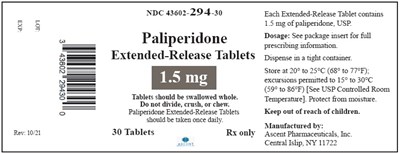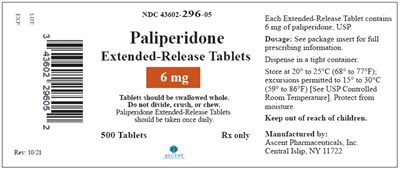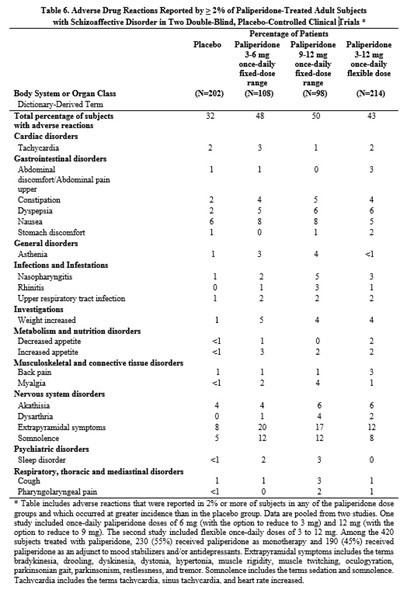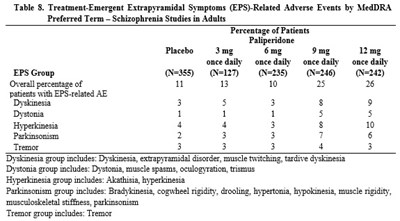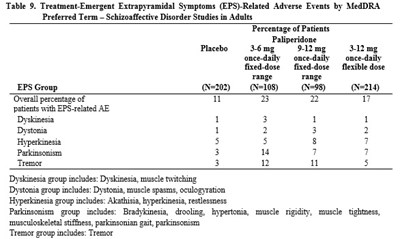Product Images Paliperidone
View Photos of Packaging, Labels & Appearance
Product Label Images
The following 26 images provide visual information about the product associated with Paliperidone NDC 43602-294 by Ascent Pharmaceuticals, Inc., such as packaging, labeling, and the appearance of the drug itself. This resource could be helpful for medical professionals, pharmacists, and patients seeking to verify medication information and ensure they have the correct product.
1.5 mg 500s - 1.5 mg 500s

This is a description for Paliperidone Extended-Release Tablets. The tablets should be swallowed whole and should not be divided, crushed, or chewed. Each tablet contains 1.5 mg of paliperidone. The recommended dosage and other important information can be found in the package insert. The tablets should be stored in a tight container at a temperature between 20°C to 25°C (68°F to 77°F), with excursions permitted to 15°C to 30°C (59°F to 86°F). It is important to protect the tablets from moisture and keep them out of reach of children. The tablets are manufactured by Ascent Pharmaceuticals, Inc. located in Central Islip, NY 11722.*
1.5 mg 7s - 1.5 mg 7s

This is a description for Paliperidone Extended-Release Tablets. These tablets are indicated for the treatment of certain mental or mood disorders. The tablets should be swallowed whole and not divided, crushed, or chewed. They should be taken once daily. Each tablet contains 1.5 mg of paliperidone, USP. The full prescribing information can be found in the package insert. The tablets should be stored in a tight container at a temperature between 20°C to 25°C (68°F to 77°F), with excursions permitted to 15°C to 30°C (59°F to 86°F). They should be protected from moisture and kept out of the reach of children. These tablets are manufactured by Ascent Pharmaceuticals, Tnc. Located in Central Islip, NY 11722.*
3 mg 30s - 3 mg 30s

This is a description for a medication called Paliperidone, specifically for the Extended-Release Tablets. The tablets should be taken once daily and swallowed whole, without dividing, crushing, or chewing them. Each tablet contains 3 mg of paliperidone, and the dosage instructions can be found in the package insert. The medication should be dispensed in a tight container and stored at a temperature between 20°C to 25°C (68°F to 77°F), with excursions permitted to 15°C to 30°C (59°F to 86°F). It is important to protect the tablets from moisture and keep them out of reach of children. The medication is manufactured by Ascent Pharmaceuticals, Tnc. in Central Islip, NY 11722.*
3 mg 500s - 3 mg 500s

This text appears to be a prescription drug description for Paliperidone Extended-Release Tablets. The tablets should be swallowed whole and should not be divided, crushed, or chewed. The recommended dosage is once daily. Each tablet contains 3 mg of paliperidone. The full prescribing information can be found in the package insert. The tablets should be stored in a tight container at a temperature of 20° to 25°C (68° to 77°F), with excursions permitted to 15° to 30°C (59° to 86°F) to protect from moisture. The medication should be kept out of reach of children. It is manufactured by Ascent Pharmaceuticals, Inc. located in Central Islip, NY 11722.*
3 mg 7s - 3 mg 7s

This is a description of a medication called Paliperidone Extended-Release Tablets. The tablets contain 3 mg of paliperidone and are prescribed to be taken once daily. The tablets should be swallowed whole and should not be divided, crushed, or chewed. The dosage and full prescribing information can be found in the package insert. The medication should be stored in a tight container at a temperature range of 20° to 25°C (68° to 77°F) with excursions permitted to 15° to 30°C (59° to 86°F). It should be protected from moisture and kept out of reach of children. The medication is manufactured by Ascent Pharmaceuticals in Central Islip, NY 11722.*
6 mg 30s - 6 mg 30s

This is a description for Paliperidone Extended-Release Tablets. Each tablet contains 6 mg of paliperidone, which is a medication used for certain mental/mood disorders. The tablets should be swallowed whole and not divided, crushed, or chewed. The recommended dosage is once daily. This medication should be dispensed in a tight container and stored at temperatures between 20°C to 25°C (68°F to 77°F), with excursions permitted to 15°C to 30°C (59°F to 86°F). It is important to protect the tablets from moisture and keep them out of reach of children. The manufacturer is Ascent Pharmaceuticals, Tnc., located in Central Islip, NY 11722.*
6 mg 7s - 6 mg 7s

This is a description of a medication called Paliperidone Extended-Release Tablets. These tablets contain 6 mg of paliperidone and should be swallowed whole once a day. It is important not to divide, crush, or chew the tablets. The full prescribing information can be found in the package insert. The tablets should be dispensed in a tight container and stored at a temperature of 20° to 25°C (68° to 77°F), with excursions permitted to 15° to 30°C (59° to 86°F). It is important to protect the tablets from moisture and keep them out of reach of children. The medication is manufactured by Ascent Pharmaceuticals, Tnc.*
9 mg 30s - 9 mg 30s

This is a description of a medication called Paliperidone Extended-Release Tablets. These tablets contain 9 mg of paliperidone, USP and should be taken once daily. It is important to swallow the tablets whole and not divide, crush, or chew them. The dosage information can be found in the package insert. The tablets should be dispensed in a tight container and stored at a temperature between 20°C to 25°C (68°F to 77°F), with excursions permitted to 15°C to 30°C (59°F to 86°F). The medication should be protected from moisture and kept out of reach of children. It is manufactured by Ascent Pharmaceuticals, Tnc.*
9 mg 500s - 9 mg 500s

This is a description of a medication called Paliperidone Extended-Release Tablets. Each tablet contains 9 mg of paliperidone, USP. The tablets should be swallowed whole and taken once daily. They should not be divided, crushed, or chewed. The package contains 500 tablets and it is for prescription-only use. The recommended storage temperature is 20° to 25°C (68° to 77°F) with excursions permitted to 15° to 30°C (59° to 86°F), and the medication should be protected from moisture. It should be kept out of reach of children. The medication is manufactured by Ascent Pharmaceuticals, Inc. located in Central Islip, NY 11722.*
9 mg 7s - 9 mg 7s

This text is a description of a medication called Paliperidone Extended-Release Tablets. The tablets should be swallowed whole and should not be divided, crushed, or chewed. The recommended dosage is one tablet per day. Each tablet contains 9 mg of paliperidone, and the full prescribing information can be found in the package insert. The medication should be stored in a tight container at a temperature of 20° to 25°C (68° to 77°F), with excursions permitted to 15° to 30°C (59° to 86°F). It is important to protect the tablets from moisture and keep them out of reach of children. The medication is manufactured by Ascent Pharmaceuticals, Tnc.*
Table10 - Table10

Table 10 displays the treatment-emergent extrapyramidal symptoms (EPS)-related adverse events observed in studies on adolescent subjects with schizophrenia. The table presents the percentage of patients experiencing these symptoms when treated with different doses of Paliperidone (15mg, 3mg, 6mg, and 12mg) once daily, compared to the placebo group. The EPS-related adverse events include hyperkinesia, dystonia, tremor, Parkinsonism, and dyskinesia. The table also provides additional information about the specific symptoms included in each group.*
Table1a - Table1a

Table 1a provides information on the change in fasting glucose levels in adults with schizophrenia from three placebo-controlled studies. The studies evaluated the effects of different doses of Paliperidone (3 mg/day, 6 mg/day, 9 mg/day, and 12 mg/day) compared to a placebo. The table presents the mean change from baseline in serum glucose levels for each dose category. The number of subjects (n) for each group is also provided. The change from baseline in serum glucose levels for each group is reported as 0.8, 0.7, 0.4, 2, and 4.3 mg/dL, respectively. Additionally, the table includes information on the proportion of patients with shifts from normal to high serum glucose levels. The percentages for each dose group are 5.1%, 32%, 45%, 48%, and 38% respectively. A shift from normal to high serum glucose levels is defined as a change from <100 mg/dL to ≥126 mg/dL. The numbers in parentheses represent the number of patients experiencing this shift over the total number of patients in each dose group. For example, in the 3 mg/day dose group, 12 out of 236 patients experienced a shift from normal to high serum glucose levels. This table provides valuable data on the effects of Paliperidone on fasting glucose levels in individuals with schizophrenia, helping to understand the potential impacts of the medication on metabolic health in this population.*
Table1b - Table1b

Table 1b presents the results of a 6-week study on the change in fasting glucose levels in adolescent subjects (12-17 years old) with schizophrenia. The study compared the effects of different doses of Paliperidone (placebo, 1.5 mg/day, 3 mg/day, 6 mg/day, and 12 mg/day) on serum glucose levels. A total of 41 subjects received placebo, while the other dose groups had varying numbers of participants. The mean change from baseline in serum glucose levels varied across the different dose groups. Specifically, the 1.5 mg/day dose resulted in an 8 mg/dL decrease, the 3 mg/day dose led to a 14 mg/dL decrease, the 6 mg/day dose showed an 18 mg/dL decrease, and the 12 mg/day dose had a negligible change of 0.1 mg/dL. Meanwhile, the placebo group experienced a 52 mg/dL increase in serum glucose levels. Additionally, the table reports the proportion of patients in each dose group who shifted from normal glucose levels (<100 mg/dL) to high levels (>2126 mg/dL). The percentages ranged from 0% to 11% in the different dose groups.*
Table2a - Table2a

Table 2a provides the change in fasting lipids from three placebo-controlled, 6-week, fixed-dose studies in adult subjects with schizophrenia. The table includes the mean change from baseline for different doses of Paliperidone (placebo, 3 mg/day, 6 mg/day, 9 mg/day, 12 mg/day) in terms of cholesterol, LDL, HDL, and triglycerides. Additionally, the table presents the proportion of patients with shifts in cholesterol, LDL, HDL, and triglycerides from normal to high levels.*
Table2b - Table2b

Table 2b provides information on the change in fasting lipids in adolescent subjects (12-17 years old) with schizophrenia, based on a placebo-controlled 6-week study. The study evaluated the impact of different doses of Paliperidone (Placcbo lSmgday, 3mgday, 6mgday, and 12mgday) on fasting lipids. The table presents the mean change from baseline for various lipid parameters, including cholesterol, LDL (low-density lipoprotein), HDL (high-density lipoprotein), and triglycerides. The data shows the change in lipid levels for each dose group compared to the placebo. Additionally, the table includes the proportion of patients experiencing shifts in lipid levels from normal to high or low ranges. Overall, the data provides insights into the effects of Paliperidone on fasting lipids in adolescent subjects with schizophrenia.*
Table3b - Table3b

Table 3b presents the results of a 6-week study examining the mean change in body weight and the proportion of subjects with a 7% gain in body weight in adolescent subjects (age 12-17) with schizophrenia. The study compared the effects of different doses of Paliperidone (1mg/day, 3mg/day, 6mg/day, and 12mg/day) to a placebo. The table provides the number of subjects in each group and the percentage of subjects experiencing weight gain.*
Table4 - Table4

Table 4 provides information on adverse reactions reported by adult subjects with schizophrenia who were treated with Paliperidone in three short-term, fixed-dose, placebo-controlled clinical trials. The table presents the percentage of patients who experienced each adverse reaction at different doses of Paliperidone. Some of the reported adverse reactions include atrioventricular block first degree, bundle branch block, sinus arrhythmia, tachycardia, abdominal pain upper, dry mouth, salivary hypersecretion, asthenia, fatigue, akathisia, dizziness, extrapyramidal symptoms, headache, somnolence, orthostatic hypotension. The table also mentions that the listed adverse reactions occurred in 2% or more of subjects in any of the Paliperidone dose groups and at a higher incidence than in the placebo group. The data is pooled from three studies with different Paliperidone doses.*
Table5 - Table5

Table 5. shows the adverse reactions reported by adolescent subjects with schizophrenia who were treated with Paliperidone in a clinical trial. The table includes the percentage of patients who experienced these reactions for different doses of Paliperidone compared to placebo. Some of the reported adverse reactions include tachycardia (increased heart rate), blurred vision, dry mouth, vomiting, fatigue, headache, weight gain, dizziness, extrapyramidal symptoms, somnolence (sleepiness), anxiety, reproductive system and breast disorders, and respiratory disorders. Please note that this description is based on text and may contain errors or omissions.*
Table7 - Table7

Table 7 provides information about the treatment-emergent extrapyramidal symptoms (EPS) in adults with schizophrenia, specifically focusing on the incidence of rating scales and the use of anticholinergic medication. The table includes the percentages of patients experiencing different EPS symptoms, such as Parkinsonism and Akathisia, while being treated with Paliperidone at varying doses (6mg, 9mg, and 12mg). It also shows the percentage of patients who received anticholinergic medications to address the emergent EPS symptoms. Additionally, it mentions the criteria for assessing EPS symptoms using scoring scales, such as the Simpson Angus global score and the Barnes Akathisia Rating Scale. Overall, the table provides a comprehensive overview of the treatment and management of EPS in adults with schizophrenia.*
* The product label images have been analyzed using a combination of traditional computing and machine learning techniques. It should be noted that the descriptions provided may not be entirely accurate as they are experimental in nature. Use the information in this page at your own discretion and risk.
